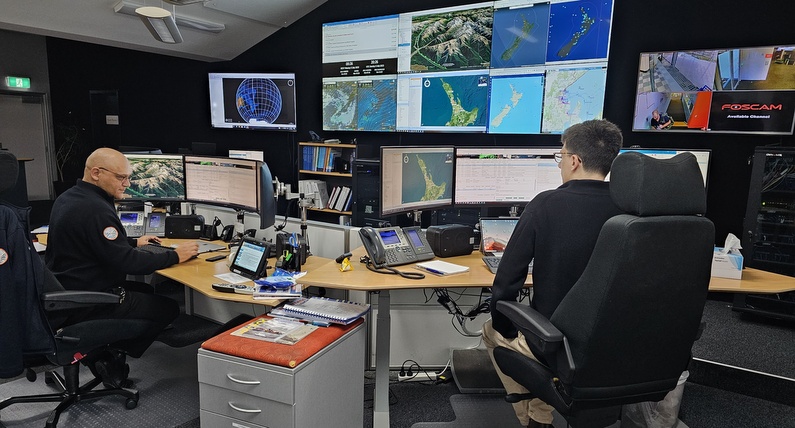
Day in the life of a SARO
A glimpse into the work of the Search and Rescue Officers (SAROs) at the Rescue Coordination Centre New Zealand (RCCNZ).
Located in Lower Hutt, RCCNZ coordinates all Category II SAROPS within New Zealand’s 30 million square kilometre search and rescue region. These SAROPS include all the offshore maritime and aviation search and rescue missions, and land missions that start with a dis-tress beacon activation.
During an average shift, two SAROs each manage a range of alert-ing, tracking, mapping and logging systems from their workstation. Google Earth is the primary geographic information systems tool, used for developing search areas, analysing terrain and tracking assets. The SARO’s have topographical, aviation and maritime chart layers available to them.
Alerts come from a range of sources, such as the Global Maritime Distress and Safety System. This includes VHF and HF radio, the Cospas-Sarsat distress beacon system and other methods of satellite alerting from vessels, aircraft and individuals.
For each response, a SAR Mission Coordinator is in charge, with the rest of the watch contributing. However, sometimes multiple situations can be unfolding simultaneously, each with their own SAR Mission Coordinator. Every action is logged on RCCNZ’s incident management system, which supports operational review. This also enables shift handovers, as some incidents can take multiple days to resolve.
In the quiet periods, SAROs work on a variety of projects, such as developing training packages, updating SAR plans for distinct regions like Antarctica, or delivering SAR training to Pacific islands within New Zealand's search and rescue region.
Across the hallway is the Maritime Operations Centre, where a team operate a suite of radio and satellite communication gear. They provide the tactical communications with SAR assets and those in distress, whilst the SAROs provide the strategy, planning and decision-making.
Many SAR volunteers will be aware how RCCNZ coordinates land-based and close-to-shore responses to distress beacon activations. However, a lot of the incidents occur hundreds or thousands of kilome-tres offshore, such as a ‘Man overboard’ situation on an international fishing vessel. For example, when involving a Chinese-flagged vessel, SAROs work closely with the English speaking team at the Maritime Rescue Coordination Centre China, to coordinate search patterns with other vessels in the area that are looking for the missing person.
When a New Zealand registered distress beacon is activated overseas, RCCNZ contacts the local authorities to ensure a response is underway. Last year, a Kiwi on a dive trip in Mexico activated his beacon when the vessel they were on ran aground in the night and began sinking. RCCNZ was able to liaise with the US Coast Guard and the Mexican authorities, and with the help of an interpreter, found out that the rescue was underway and the New Zealand citizen safely accounted for. SAROs were able to relay this information to the man’s family back home, which they greatly appreciated.
Often small fishing vessels from Kiribati are reported missing. In the last five years RCCNZ have been notified of these situations on average once a month. Kiribati is located in the Fiji search and rescue region, but adjacent SAR authorities such as Australia, United States and New Zealand take turns supporting Fiji with long-range SAR aircraft to aid in the search. There’s a lot of international liaison, with a very positive attitude to the shared goal of saving life.
Altogether, a minimum of two of the 16 SARO’s at RCCNZ are on duty at any given hour of the day or night, ready to use their skills and experience to assist those in distress within New Zealand's search and rescue region; an area roughly the size of the continent of Africa.
Thank you to Samantha Mildon, Watch Leader and Michael Clulow, Manager Operations at RCCNZ for their support producing this article.
This article was first published in the September 2023 issue of Link magazine.
Feature image: RCCNZ Operations room. Supplied
